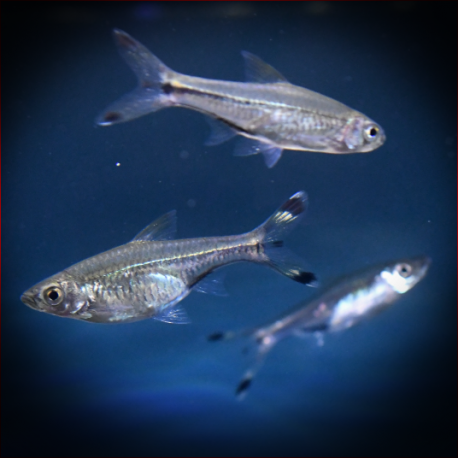More info
Datasheet
| Minimum Tank Size | 255 litres / 67.36 US gallons |
| Maximum Size | 15.2cm / 5.98inches |
| Temperature | 22°C / 71.60°F - 25°C / 77.00°F |
| Hardness | 2-12ºdH |
| pH | 5.0-8.0 |
General Description
The Scissortail Rasbora, also known as the three-lined rasbora, is a peaceful species that thrives in community tanks. It is an excellent choice for beginners in the hobby due to its adaptability. With its characteristic twitching motion of the caudal fin, this species can be distinguished by its larger size compared to similar counterparts. This fish feeds mainly on invertebrates in the wild but accepts dried and live foods in aquariums.
Aquarium Setup
For a thriving tank environment, a large, well-planted aquarium is recommended for the Scissortail Rasbora. Consider recreating natural habitats such as flowing rivers with rocks, gravel, and boulders, or peat swamp-type environments with dim lighting, driftwood, leaf litter, and aquatic plants. Ensure tight-fitting covers as this species is a surface-dweller and prone to jumping. Water must be spotless at all times due to its intolerance to organic waste accumulation.
Behaviour
Being a gregarious species, the Scissortail Rasbora thrives in groups of at least six, displaying better colors in the presence of conspecifics. This peaceful nature allows it to coexist with various fish species in a community tank setting, making it a versatile choice for aquarists.
Feeding and Diet
In the aquarium, the Scissortail Rasbora feeds on a diet mainly composed of invertebrates, including insects. While accepting dried foods, supplementing with live and frozen options like Daphnia and Artemia is crucial for maintaining optimal coloration and triggering breeding conditions.
Reproduction & Dimorphism
This species is an egg-scattering, continuous spawner, exhibiting no parental care. Conditioned adults can spawn in a mature aquarium naturally, but controlled breeding methods involving separate containers with dim lighting and mesh surfaces are recommended for a higher fry yield. Mature females exhibit a rounder belly, distinguishing them from males.
Habitat and Distribution
Native to the Chao Phraya and lower Mekong river basins in Southeast Asia, the Scissortail Rasbora thrives in various habitats ranging from swiftly-flowing streams to blackwaters with decomposing organic matter. Its distribution extends to Peninsular Malaysia, Sumatra, and Borneo, where it inhabits reservoirs, lakes, and flooded areas during the wet season. Commercial breeding efforts have reduced reliance on wild-caught individuals.

